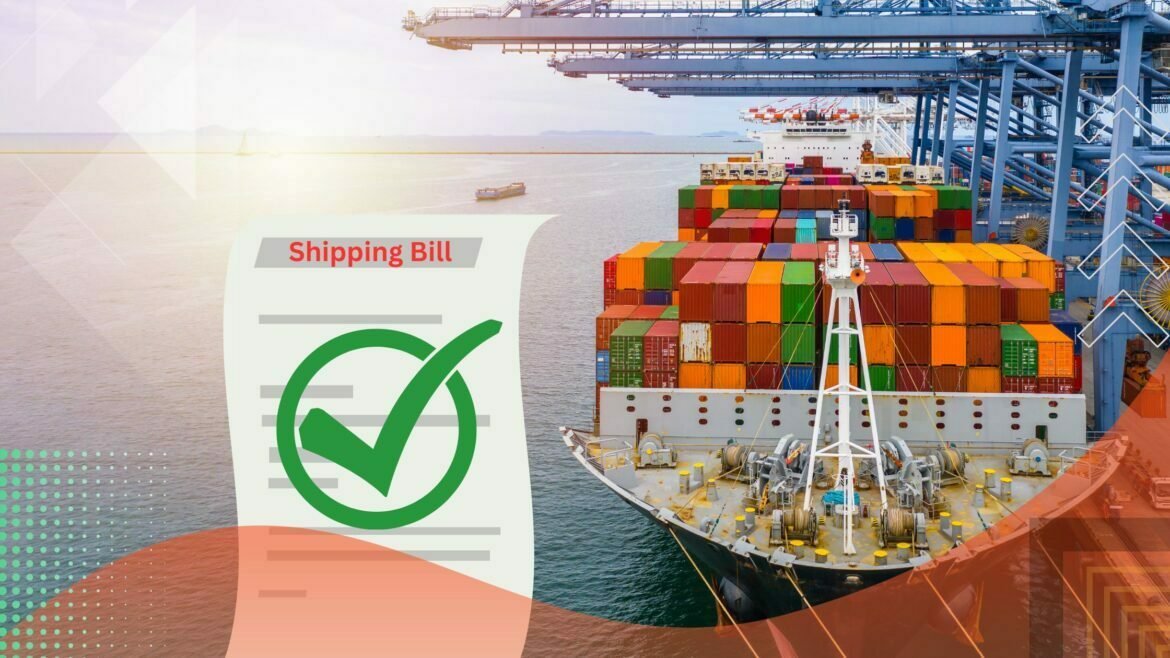The Shipping Bills for export hold greatest significance in the export process. A comprehensive set of paperwork and processes must be followed in order to export commodities from one nation to another. It is a key document that permits and governs the transportation of commodities from Indian coasts to other countries. A thorough overview of the sorts, importance, elements, processes, and ramifications for exporters of the shipping bill is provided.
The term “export documentation” refers to a broad range of documents needed for cross-border business transactions. It consists of paperwork pertaining to the purchase, transportation, and delivery of products from the vendor to the customer. An essential component of this paperwork are shipping bills.
Role of Shipping Bills
One of the most important parts of export documentation is the shipping bill. They give specific information on the exported items to the customs authorities, assisting in ensuring compliance with trade laws and promoting the easy movement of goods across borders.
In addition to commercial invoices and packing lists, other export papers having a close connection to shipping bills include certificates of origin. These documents work as a whole to offer complete details about the goods, their value, and their place of origin, assisting the export process.
Types The Shipping Bills for Export
There are different types of shipping bills, each one designed for a particular export circumstance. For exporters, having an understanding of these kinds is crucial. Here are the primary types of shipping bills:
- Free Shipping Bill: When there are no export duties due on the exported products, free shipping bills are utilized. It applies to products that qualify for duty-free export.
- Drawback Shipping Bill: When goods are exported along with a claim for a duty drawback, this Shipping Bill is used. Duty drawback is the practice of receiving back the customs fees paid on materials imported for use in manufacturing goods for export.
- Export under Bond Shipping Bill: When goods are exported under a bond, which implies they are exempt from paying customs charges at the time of export, this kind of shipping bill is utilized. The bond serves as a promise to the customs officials that the items would be returned to India or that the value of them will be recovered within a certain time frame.
- Export under Rebate Shipping Bill: When merchandise is exported as part of a rebate program, this Shipping Bill is utilized. Refunds of tariffs on materials used in the production or processing of export goods are referred to as rebates.
- Export Promotion Scheme Shipping Bill: When commodities are shipped under particular export promotion programs, such as the Merchandise Exports from India Scheme (MEIS) or the Export Promotion Capital commodities (EPCG) program, this kind of shipping bill is utilized. These programs offer rewards and incentives to stimulate certain industries and promote exports.
- Re-export Shipping Bill: When goods that were previously imported into India are re-exported, a re-export Shipping Bill is used. This Shipping Bill is required to ensure compliance with customs procedures and to claim any applicable duty exemption or drawback.
- Manufacturer Exporter Shipping Bill: When the exporter is also the maker of the items being exported, this sort of shipping bill is employed. Additional paperwork is needed to demonstrate the manufacturing state, such as supplier bills, production-related records, and proof of value addition.
- Merchant Exporter Shipping Bill: A merchant exporter Shipping Bill is utilized when the exporter is not the manufacturer but rather serves as a middleman, buying products from manufacturers and exporting them. Documentation like purchase receipts, sales contracts, and evidence of ownership or permission to export the items are required for this kind of shipping bill.
Components of the Shipping Bill :
The Shipping Bill contains essential information related to the export transaction, including:
- Exporter Details: The exporter’s name, address, and phone number are shown here, along with any pertinent registration numbers such the Import Export Code (IEC).
- Consignee Details: The person or organization to whom the products are being transported is referred to as the consignee. The name, address, and contact details of the consignee are recorded on the shipping bill.
- Description of Goods: The nature, number, weight, classification, and value of the exported items are all described in detail in this section. The Harmonized System of Nomenclature (HSN) code is also mentioned to ensure accurate categorization.
- Invoice and Payment Details: Information concerning the commercial invoice, such as the invoice number, date, the amount of the items, and the currency used in the transaction, is needed for the shipping bill. Additionally, it records payment information such the method of payment, the currency of the invoice, and the pertinent foreign exchange realization certificate.
- Port of Loading and Destination: The port of loading in India and the port of expected arrival in the importing nation are both specified on the shipping bill. For the sake of logistics and customs clearance, these information are essential.
- Export Scheme and Benefits: The Shipping Bill specifically states if the export was carried out in accordance with any specific export promotion program, such as the Merchandise Exports from India program (MEIS) or the Export Promotion Capital Goods (EPCG) scheme.
Export Procedures and Submission :
- Filing: The Shipping Bill must be submitted electronically using the Indian Customs Electronic Data Interchange System (ICES)/Indian Customs EDI System (ICES) by the exporter or their authorized representative.
- Classification: The Shipping Bill must be submitted electronically using the Indian Customs Electronic Data Interchange System (ICES)/Indian Customs EDI System (ICES) by the exporter or their authorized representative.
- Supporting Documents: The exporter must attach supporting documents, such as the commercial invoice, packing list, transport documents (such as the Bill of Lading or Airway Bill), export license (if applicable), and any certificates or permits required for specific goods (e.g., phytosanitary certificate for agricultural products).
- Customs Clearance: The customs officials examine the Shipping Bill and any supplementary documentation after receiving it. They provide the export shipment customs clearance if everything is in order.
Implications and Importance of the Shipping Bill :
- Customs Clearance: An essential document for customs clearance is the shipping bill. It guarantees adherence to customs regulations, including the collection of duties and taxes, the inspection of commodities, and adherence to export control legislation.
- Export Promotion Schemes: The Shipping Bill records data on export promotion programs. This makes it easier for exporters to take advantage of numerous advantages offered by these programs, such as duty drawback, tax exemptions, or cash incentives.
- Trade Statistics: The data in the Shipping Bill is used to produce trade statistics, which aids in the government’s study of export patterns, sectoral growth, and policy formulation.
- Compliance and Legal Requirements: The Shipping Bill guarantees that exporters abide by a number of legal criteria, including export rules for particular items, exchange control laws, and international trade policies.
- Documentation and Transactional Record: The Shipping Bill serves as a crucial record-keeping tool for export operations. It acts as proof of the export contract and promotes effective communication among all parties involved, including banks, shipping firms, and insurance organizations.
Recent Developments and Digitalization :
The Indian government has made major efforts recently through digitization initiatives to simplify export processes and increase the effectiveness of the Shipping Bill. Online filing, submission, and processing of the Shipping Bill have been made easier by the establishment of the Indian Customs Electronic Data Interchange System (ICES)/Indian Customs EDI System (ICES). This has decreased paperwork, limited manual interventions, and sped up the export procedure as a whole.
Additionally, the launch of the Indian Customs Electronic Gateway (ICEGATE) site has improved accessibility and transparency even more. Through a single online portal, exporters may now obtain pertinent information, monitor the progress of their shipping bills, and interact with customs officials. This move toward digitization has increased operational effectiveness while minimizing the possibility of mistakes and inconsistencies.
Challenges and the Way Forward :
- Complexity and Compliance: The process of creating a shipping bill requires adherence to a number of laws, categorization standards, and paperwork. To maintain compliance, exporters must keep informed about changes to export laws and customs practices.
- System Integration: For seamless information flow and effective processing, numerous parties, including customs, banks, and shipping businesses, must integrate their various systems and platforms. Enhancing system integration and interoperability requires ongoing work.
- Capacity Building: It is important to guarantee that exporters and customs authorities have the knowledge and abilities to use digital platforms and systems. The skill gap can be closed and overall competency increased with adequate training and capacity-building activities.
- Cybersecurity: Cybersecurity dangers are a growing worry as digitalization advances. The government and other parties concerned should place a high premium on safeguarding private information linked to exports and making sure that digital platforms are reliable.
Looking ahead, the way forward involves:
- Continued Digital Transformation: Adopting cutting-edge technology can improve the effectiveness, transparency, and security of the shipping bill process. Examples include blockchain, artificial intelligence, and machine learning. This shift may be sped up through cooperation between governmental entities, business associations, and technological professionals.
- Simplification and Harmonization: The Shipping Bill process may be made more user-friendly and manageable by streamlining export procedures, cutting redundancies, and harmonizing paperwork requirements. The simplicity of conducting business will improve as long as efforts are made to streamline procedures and cut down on paperwork.
- Stakeholder Engagement: Understanding the pain points and removing any bottlenecks in the shipping bill process requires regular communication with exporters, customs officials, and other stakeholders. Collaboration and open discussion may result in practical solutions and ongoing progress.
India’s Agricultural Export Hub
Exploring the Difference Between Invoice Value and Assessed Value
The Realities of Export Bill Financing
The Bill of Exchange in Exports
For further information on export documentation, customs compliance, and the evolving landscape of international trade, explore the resources provided below:


1 comment
[…] The Shipping Bills for Export […]